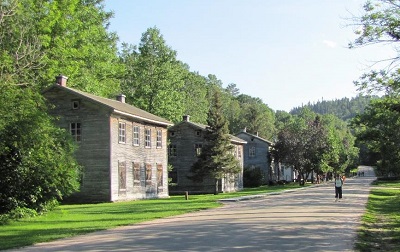Historic Village of Val-Jalbert National Historic Site of Canada
Chambord, Quebec

Saint-Georges street
(© Parcs Canada | Parks Canada)
Address :
95 Saint-Georges Street, Chambord, Quebec
Recognition Statute:
Historic Sites and Monuments Act (R.S.C., 1985, c. H-4)
Designation Date:
2019-07-26
Dates:
-
1901 to 1927
(Construction)
-
1901 to 1903
(Established)
Event, Person, Organization:
-
Ludger Cimon
(Architect)
-
Alfred Lamontagne
(Architect)
Other Name(s):
-
Historic Village of Val-Jalbert
(Designation Name)
-
Ouiatchouan
(Other Name)
-
Ouiatchouan Falls
(Other Name)
-
Village-fantôme de Val-Jalbert
(Other Name)
Research Report Number:
2018-23
Plaque(s)
Existing plaque: Chambord, Quebec
The establishment of a pulp and paper mill by industrialist Damase Jalbert in 1901 led to the foundation of this village on the banks of the Ouiatchouan River (“site of frequent travel” in Ilnu). A prime example of a company village built to retain its workforce, Val Jalbert is remarkable for its diverse homes and array of institutional and commercial buildings, unique in industrial complexes of the time. The mill’s closure in 1927 led to the gradual abandonment of the village. The conservation and development of this site, which began in the 1960s, reflected growing interest in the preservation of built heritage in Canada.
Description of Historic Place
The Historic Village of Val-Jalbert National Historic Site of Canada covers an area of roughly 1.88 km2 located halfway between Chambord and Roberval in the Regional County Municipality (RCM) of Domaine du Roy, southwest of Lac Saint Jean, Quebec. It has over 90 buildings, including a pulp mill, institutional and commercial buildings, houses and tourist facilities, as well as the remains of many other structures. The official recognition refers to the boundaries of the Historic Village of Val Jalbert as designated under Quebec’s Cultural Property Act in 1996. Some discordant elements have been excluded, including the visitor reception centre and the adjacent garage, which are of fairly recent construction, as well as the camping site located near the site entrance.
Heritage Value
The Historic Village of Val-Jalbert was designated a National Historic Site of Canada in 2019. It is designated because founded in 1901 around a pulp and paper mill, and deserted since 1927, the village of Val-Jalbert is a prime example of an early 20th century pulp and paper industry company town. It is remarkable for its authenticity and the integrity of its built environment; designed in successive phases according to an urban plan that guided its growth, the village of Val-Jalbert features the two distinct districts of the upper town and the lower town, as well as a unique array of industrial facilities, institutional and commercial buildings, and four different types of workers’ all-wood houses found along over a half-dozen streets; and the conservation and development of this “ghost town” into an open-air museum in the early 1960s typified the growing interest in heritage preservation that took place across the country during the second half of the 20th century.
In 1898, forestry entrepreneur Damase Jalbert began developing a pulp mill on the Ouiatchouan River. The village’s first residential area was planned while the mill, inaugurated in 1902, was being constructed. The site’s natural topography includes the Ouiatchouan River and its waterfalls, the river canyon, woods and a network of roads and trails. Four different types of workers’ housing are erected in the village’s two primary residential areas, known as upper and lower town. In 1924, a crisis in the pulp industry led to the layoff of workers, who were forced to seek employment in nearby communities. Due to financial difficulties, the Val Jalbert pulp mill officially closed its doors on August 13, 1927. In August 1949, the Quebec government acquired the Val Jalbert facilities, but the site didn’t open to visitors until 1960. Largely intact, the site has retained its original layout. Over the years, some 30 houses have been restored, as have other major buildings that serve various functions for visitors today, including the mill, general store, butcher shop, convent school and guest house. A dozen other houses have been intentionally left in a state of ruin.
Source: Historic Sites and Monuments Board of Canada, Minutes, December 2018.
Character-Defining Elements
Key elements contributing to the heritage value of this site include
its location in Chambord in the Saguenay–Lac Saint-Jean region in Quebec; its location along the Ouiatchouan River and proximity to the Maligne falls; the many natural features that shape the site, including the Ouiatchouan River and its two waterfalls, the river canyon, the woods, the network of roads and trails, and the topography characterized by the steep vertical drop from the falls; the preservation of the original layout of the village’s primary built up areas, lower and upper town; its 94 buildings, which include a pulp mill, institutional and commercial buildings, houses, and tourist facilities, including the mill (interpretive centre and restaurant), general store (gift shop and gathering place for theatrical presentations), old butcher shop, convent school (interpretive centre with activities and exhibits) and guest house; the many examples that remain of the village’s original four types of housing (types I, II, III and IV), built between 1901 and 1924; the many overgrown foundations that mark the village’s lost buildings (25 houses and the flour mill, sawmill, debarking room, repair shop, abattoir, rectory and church); the use of wood as a construction and cladding material for all the buildings in Val Jalbert, which gives the village stylistic unity; and the use of stone in the pulp mill complex.